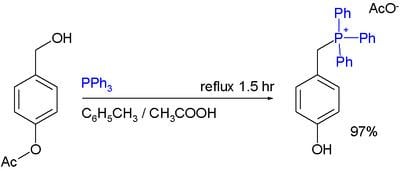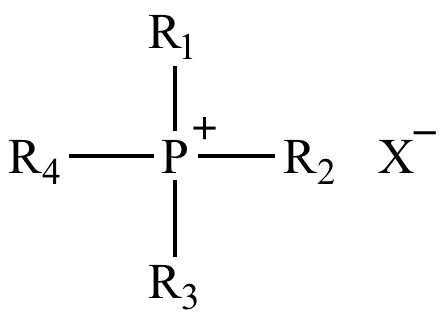Formula PH4+ | ||
 | ||
How to make a phosphonium ylide for the wittig reaction organic chemistry
The phosphonium (more obscurely: phosphinium) cation describes polyatomic cations with the chemical formula PR+
4. A phosphonium salt is a salt containing either the phosphonium (PH4+) ion, such as phosphonium iodide (PH4+I−) or, more commonly, an organic derivative such as the quaternary phosphonium salts tetraphenylphosphonium chloride, (C6H5)4P+ Cl− and tetramethylphosphonium iodide, [P(CH3)4]+I−. Salts of the parent PH+
4 are rarely encountered, but this ion is an intermediate in the preparation of the industrially useful tetrakis(hydroxymethyl)phosphonium chloride:
Contents
- How to make a phosphonium ylide for the wittig reaction organic chemistry
- Use for preparation of Wittig reagents
- Synthesis of phosphonium acetates
- Phosphonium halides
- References

2OH)+
4Cl−
Organic phosphonium salts are common reagents in the laboratory. Those with a P–H bond are produced through protonation of phosphines:

3
Many organic quaternary phosphonium cations (PR+
4) are produced by alkylation of organophosphines. For example, the reaction of triphenylphosphine with methyl iodide gives methyltriphenylphosphonium iodide, the precursor to a Wittig reagent:

3PPh+
3I−
The cation tetraphenylphosphonium (PPh+
4) is a useful precipitating agent, analogous to quaternary ammonium salts used in phase transfer catalysis.

Use for preparation of Wittig reagents

Alkyltriphenylphosphonium salts are widely used for the preparation of Wittig reagents for the Wittig reaction. Such salts are readily made by the reaction of triphenylphosphine with an alkyl halide:
Note that Ph stands for phenyl and X is a halideThe reaction works well if the alkyl group is methyl or an unhindered primary alkyl group (as shown), but it is usually poor with secondary alkyl halides. Tertiary alkyl groups cannot form the ylide. The phosphonium salt is a stable compound which can often be purified by recrystallisation from ethanol.
To form the Wittig reagent (ylide), the phosphonium salt is suspended in a solvent such as diethyl ether or THF and a strong base such as phenyllithium or n-butyllithium is added.
Synthesis of phosphonium acetates
One study demonstrates the use of benzyl alcohols as starting material for the synthesis of phosphonium acetates provided that the arene carries activating groups:
Note that Ac stands for acetyl, the ester group is hydrolyzed to a phenolThe phosphonium acetate group does not affect the subsequent Wittig reaction.
Phosphonium halides
Phosphines (R3P) react with halogens (X2) to phosphonium halides of the type R3PX2. The compound Ph3PBr2 (high melting solid) formed by reaction of triphenylphosphine and bromine is called bromotriphenylphosphonium bromide or dibromotriphenylphosphorane and can be used in the Kirsanov reaction. The dibromide and dichloride are commercially available as halogenation reagents, for instance in halogenation of alcohols (similar to the Appel reaction) and the ring halogenation phenols,
The compound triphenylphosphine dichloride, Ph3PCl2, is reported as being an ionic compound (PPh3Cl)+Cl− in polar solutions and a molecular species with trigonal bipyramidal molecular geometry in apolar solution and in the solid state. It has been found that tetrahedral ionic compounds of the type R3PX2 continually undergo a racemising degenerate nucleophilic substitution in polar solutions.
